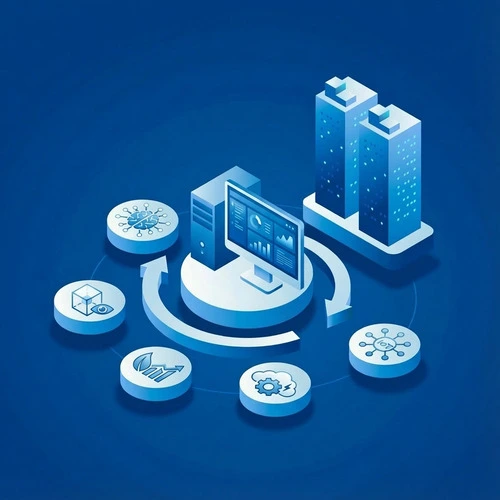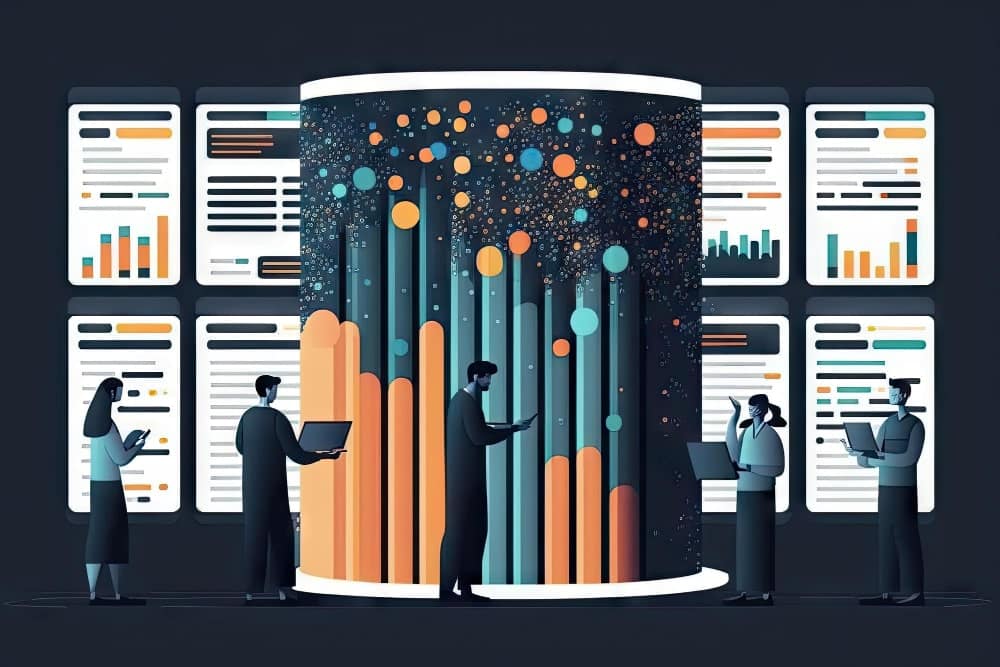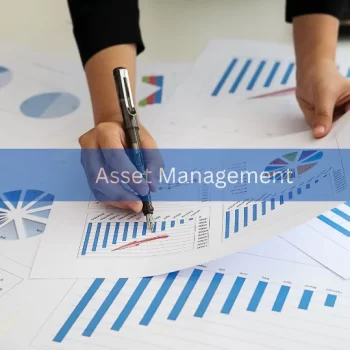Without an enterprise asset management system, enterprises can face major technical, legal, and operational roadblocks. Even so, as your organization grows and asset requirements become more complex, implementing the right EAM system can be a challenge in its own right. This article explores common challenges in Enterprise Asset Management and provides actionable strategies and best practices for overcoming them with modern solutions.
What is Enterprise Asset Management?
Think of an EAM system as the major overseer of all your organization’s assets. The lifecycle of every physical and digital asset must be tracked, maintained, and optimized through this system. In most major organizations, EAM systems are categorized into three primary roles: IT Infrastructure Asset Management, Facility Asset Management, and Manufacturing/Production Asset Management.
With a robust EAM system in place, organizations can:
- Manage vendor relationships, which ensure the procurement of spare parts and warranties.
- Track the use of all assets, including their locations and conditions.
- Ensure proactive maintenance through automated quality checks.
- Gain actionable insights to improve future asset management practices.
Why Enterprise Asset Management Matters
With a robust enterprise asset management system in place, your organization can optimize costs and improve operational efficiency. The practice of asset management will also evolve from a basic back-office function to something that provides a strategic business advantage that
- Ensures sustainability by improving asset lifecycle management.
- Reduces the repeat cost of replacements and repairs.
- Boosts operational reliability of all assets.
- Keeps a strong check on asset regulatory compliance and audit trails.
Related Blog: Software Asset Management system for Modern Businesses
Common Challenges in Enterprise Asset Management
It is quite normal for organizations to go through a ‘teething phase” when implementing new and unfamiliar systems. When implementing an EAM system, you may encounter hiccups that can disrupt the efficient management of your assets.
1. Lack of Centralized Asset Visibility
Problem: As your inventory grows, asset data may get scattered across the many departments and systems, resulting in a loss of control when it comes to performance tracking
Solution: Utilize an EAM system that can easily integrate with your IoT, ERP, and ITSM systems. This helps create a central hub for collecting all asset data for real-time analysis and unified reporting.
Best Practice: Integrating SAP EAM or IBM Maximo enables real-time tracking of asset data, including health, maintenance history, and performance metrics, in a centralized dashboard.
2. Inefficient Maintenance Management
Problem: Responses to asset issues are reactive rather than proactive, resulting in higher maintenance costs.
Solution: Use IoT sensors and analytics tools that help predict potential failures in asset performance, thereby mitigating high repair costs.
Best Practice: Scheduling automated alerts for equipment servicing will help your team proactively address asset issues.
3. Poor Data Accuracy and Standardization
Problem: Manual tracking and data entry practices can often lead to inaccurate asset records.
Solution: Implement an automated data entry procedure using barcodes, QR codes, or RFID tags.
Best Practice: Conduct periodic asset data audits and standardize asset naming conventions.
4. Limited Integration with Other Business Systems
Problem: Using an EAM system that is outdated or doesn’t support seamless integration with other key systems, such as ERP, procurement, or IT management tools.
Solution: Connectivity across your organization’s systems is crucial for better cost allocation, unified reporting, and cross-departmental insights. Make sure to choose an EAM system with open API integration capabilities.
Best Practice: Integrating your various operational systems eliminates redundant workflows and provides a holistic view of asset performance.
5. Compliance and Security Risks
Problem: Without a robust enterprise asset management system in place, your organization could face severe penalties for non-compliance and inadequate audit checks during asset procurement and maintenance.
Solution: Most good EAM systems include built-in regulatory compliance capabilities. A key framework is ISO 55000 – a required standard for maintaining governance and data integrity.
Best Practice: Grant access to sensitive asset data only to authorized personnel by using secure logging and role-based permissions.
6. Resistance to Change and Lack of Training
Problem: No matter how advanced your enterprise asset management system is, leveraging its capabilities will be challenging if your employees lack operational know-how.
Solution: A well-structured training program, combined with performance and change management initiatives, will go a long way toward ensuring your workforce makes the most of the implemented enterprise asset management system.
Best Practice: Start with pilot programs to demonstrate quick wins before full rollout.

Benefits of Overcoming EAM Challenges
As with any organization, your end goal is to achieve high operational efficiency and long-term cost savings. By overcoming the many challenges of enterprise asset management implementation, you will be able to notice:
- Enhanced operational visibility
- Reduced downtime and maintenance costs
- Improved compliance and audit readiness
- Optimized asset utilization and lifecycle management
- Stronger collaboration between departments
Choosing the Right Enterprise Asset Management Solution
Before adopting an enterprise asset management solution for your organization, consider the following:

- Your organization’s asset complexity and scale
- Features like real-time monitoring, automation, and integration capabilities
- The user-friendliness, scalability, and vendor support
With those parameters ticked off, the next step is choosing the right system that complements your organizational workflow.
| Use Case | Best Choice |
| SMBs, Enterprises, Manufacturing, Healthcare, BFSI, Retails, Government, and Telecom. | Infraon |
| Heavy industries, utilities, oil & gas, transport | IBM Maximo |
| Enterprises seeking ERP + EAM unification | SAP EAM or Oracle EBS |
| Mid-to-large companies wanting modern UX and cloud deployment | Infor EAM |
| SMBs needing IT + asset management visibility | Motadata |
| Organizations already on Oracle ERP | Oracle E-Business Suite |
Future Trends in Enterprise Asset Management
Technology is ever-evolving, so it is safe to assume that innovation in enterprise asset management systems will continue. As we move from reactive maintenance to intelligent, self-optimizing ecosystems, expect the following trends:

- AI-driven predictive maintenance
- IoT-based asset connectivity and real-time analytics
- Cloud-based enterprise asset management platforms for remote management
- Integration with sustainability reporting systems
- Advanced visualization and AR-based maintenance tools
Conclusion
Are you deploying or redeploying an EAM system? Check off everything on our list and ensure your workforce is well prepared for change. Having a future-ready enterprise asset management system ensures your assets complement your drive for continuous improvement and building a competitive advantage.
Need an all-in-one enterprise asset management solution? Infraon’s IT Asset Management Software offers a fully integrated, easy-to-use solution to manage end-to-end IT and non-IT assets. You can quickly optimize asset use and costs, extend asset lifecycles, and achieve end-to-end compliance by adopting the best practices.
Infraon Assets Empowers Teams to Overcome Fragmented Visibility
Infraon Assets, our AI-based software module, reduces the strain of dispersed data by offering complete lifecycle tracking for IT and non-IT assets. It consolidates vendor records, movements, usage, and condition reports, helping teams bypass the visibility issues. Its real-time discovery feature keeps teams informed about hardware, software, and field equipment across locations.
Moreover, maintenance schedules, warranty checkpoints, and AMC cycles easily move forward through structured workflows. Its effortless integration with our ITSM software module also strengthens coordination, while automated updates remove friction across departments.
Software highlights:
- Real-time discovery for all asset types
- One view of contracts, warranties, and AMCs
- Role-based access for sensitive records
- Vendor coordination and renewal actions in one flow
Learn more: https://infraon.io/asset-management-software.html
FAQs
What is an enterprise asset management system?
It’s a software platform that helps organizations manage, maintain, and optimize physical and digital assets throughout their lifecycle.
What are the most common EAM challenges organizations face?
Key challenges include limited data visibility, inefficient maintenance, poor data accuracy, and integration issues.
How do enterprise asset management solutions improve efficiency?
They automate tracking, centralize data, and enable predictive maintenance, reducing downtime and costs.
What are some enterprise asset management best practices?
Centralized asset tracking, data standardization, process automation, and regular audits are core best practices.
Which industries benefit most from enterprise asset management systems?
The manufacturing, energy, utilities, healthcare, IT, and transportation sectors rely heavily on enterprise asset management to optimize asset control.



















